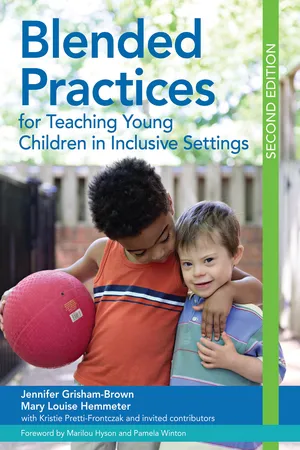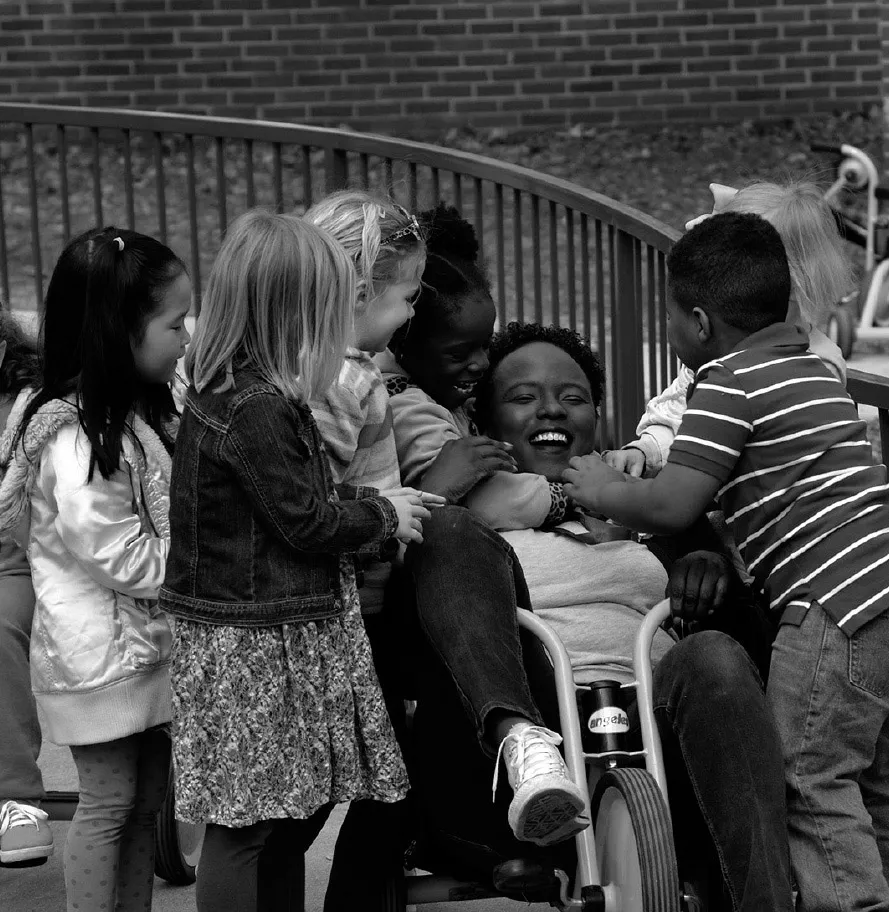![]()
SECTION III
Special Considerations in the Application of Blended Practices
![]()
CHAPTER 8
The Team Process of Planning, Implementing, and Revising Instruction
Julie Harp Rutland, Sarah Hawkins-Lear, Jennifer Grisham-Brown, and Mary Louise Hemmeter
Ms. Abby has just met a new child and family that will be joining her blended preschool class. Her program is operated by the local public school system and includes children with developmental delays, children who qualify for Head Start, and children whose families have elected for their children to have preschool experience. Lili is her new child, is 4 years old, and has significant disabilities. It was important to Lili’s parents that she receive the best care during her first 3 years; therefore, they kept her at home with her grandmother due to her significant needs. As her parents look ahead to Lili entering kindergarten, they feel she would benefit from an inclusive preschool classroom experience with other children with and without disabilities. Lili’s mother has concerns about her ability to interact with other children, which is based on limited experiences with other children her age. The family knows how to interact with Lili at home and knows how she responds. Lili’s mother is concerned that teachers and children at the preschool will not know how to interact with her like they do at home. Lili’s transdisciplinary assessment shows that she has developmental delays in the areas of communication, social-emotional, cognition, and fine motor. Ms. Abby now understands that she will have to rely on the parent’s knowledge of Lili and the expertise of therapists as she considers how to best support Lili in her first school experience. Ms. Abby is left wondering how she can accomplish this task, despite having access to those resources. Where does she begin?
Ms. Abby, like many other teachers, is challenged to meet the needs of a child such as Lili, along with an entire class of individual and unique children and families. In addition to planning for children and families, it is important for teachers to understand the services and supports available to them. Prekindergarten (pre-K) classrooms are increasingly similar to Ms. Abby’s in that they blend program resources from a variety of sources (e.g., Head Start, publicly funded preschools/pre-K, child care settings). Duplication of services, supports, and resources may create inconsistency and inefficiency as a result of blending funding resources. For example, a child may qualify for both Head Start and publicly funded preschool/pre-K in their state. The child in this scenario would automatically be assigned a family service provider through Head Start and would also qualify for family resource services through the public school system. Although the child and family would benefit from such services, consideration must be given to duplication of services such as referrals to resources. Another overlap may occur in home visiting practices. Head Start and publicly funded preschools/pre-K practice home visiting, so this family would have an extraordinary amount of home visits scheduled throughout the year.
Teachers in such programs must also adhere to the regulations of both programs, which may lead to multiple assessment tools for the child and classroom. Head Start may use one assessment tool to evaluate the classroom environment, whereas the publicly funded preschool/pre-K may use a different assessment tool. This creates duplication in classroom assessment for the teacher of a blended classroom. Furthermore, each of the programs has program review periods. For example, if Head Start has a review every third year and the publicly funded preschool/pre-K has a review every fifth year, then there will come a year in which both programs are under review. As you can imagine, this can be overwhelming for many teachers.
Ms. Abby and teachers in similar situations must rely on collaborative partnerships with all involved because of the complexity of working in a blended classroom with resources and supports from a variety of agencies. Collaborative relationships are the underpinning of the curriculum framework and tie effective teaming strategies to collaborative partnerships (see Figure 8.1). Collaborative partnerships support children, families, teachers, and related services personnel.
Figure 8.1. Illustration of the curriculum framework. (From Pretti-Frontczak, K. [2015]. Linking assessment and curriculum [Three part web-based training modules]. Brooklyn, NY: B2K Solutions, Ltd.)
This chapter provides an overview of teaming and the various individuals involved. The chapter specifically identifies members of the team (e.g., families, related services personnel, paraprofessionals, co-teachers, itinerant teachers) and how each can be involved in the process of gathering assessment information, selecting goals, planning activities and instruction, and collecting progress monitoring data. In addition, characteristics of successful teaming and challenges to teaming are described.
CHARACTERISTICS OF SUCCESSFUL TEAMING
The term team in early childhood education (ECE) suggests a group of professionals and family members that understand the importance of working together to address the needs of young children. Individually, each team member has a unique expertise, with individual values, beliefs, and experiences that shape perspectives. Members of the team, however, must recognize that they need one another to accomplish their goals. These teams may develop close working relationships over time that serve to further support the child’s development (Cloninger, 2004). Successful teaming can only be achieved, however, when all members have an understanding of their roles as they work collaboratively to share information and work toward agreed-on outcomes.
Teacher education programs tend to focus on teaching and working with the children in the classroom, but what about the adults in the classroom? Prospective teachers need to 1) be aware of the importance of partnerships with other colleagues and families and 2) understand how to create positive working relationships with other adults in order to increase the likelihood of successful inclusive practices (McCormick, Noonan, Ogata, & Heck, 2001).
Bell (2004) highlighted specific characteristics that team members should demonstrate in order to effectively work together. Individuals must be agreeable for successful teaming. This does not mean that a team member automatically agrees with all suggestions, but he or she demonstrates flexibility and mutual respect for all team members. It is inevitable that team members will have conflict, as is discussed later in this chapter, but disagreement may occur respectfully.
Being reliable, being on time for meetings and classroom visits, and being prepared for each interaction are additional characteristics of a successful team member. Simply stated, team members must be conscientious. Most all of us have been involved in a group or team in which one or more of the members were not punctual or prepared. This type of behavior hinders the success of the team. Therefore, team members should prepare in advance, arrive on time, and be organized.
Team members must be competent in their area of expertise, understanding the most up-to-date and research-based practices. Each member brings his or her own expertise, and the team depends on that knowledge. Each member has specific expertise in which he or she is responsible, regardless of the number of team members.
Finally, it is helpful to be socialized in the organization, or have an understanding of the processes and systems within. There is much to learn when working with a team in an ECE setting—school procedures and processes, teachers, families, and teaming practices and routines. Although team functioning will develop and change over periods of time, it is important that incoming members are supported as they get acclimated to the new environment (Bell, 2004).
TRANSDISCIPLINARY TEAMING
In addition to understanding the individual characteristics that contribute to successful teaming, it is also important to understand the roles and expectations of each member based on the teaming model or approach of the team. Several different teaming models may be used to deliver early childhood services, with each differing in regard to the level of family participation, team communication, assessment process, and intervention methods. The transdisciplinary model is a team of professionals that work collaboratively and share responsibilities (Cloninger, 2004). Families are full, active, and participating members of the transdisciplinary team, with team communications that are a continuous transfer of information, knowledge, and skills. Transdisciplinary teams conduct assessments together and develop plans based on family priorities, needs, and resources. One person is the primary service provider for the child and family in a transdisciplinary team, and the other team members provide support by sharing information about strategies and information specific to their expertise. All team members are responsible for sharing their knowledge with the primary service provider, and the primary service provider is responsible for implementing the plan with the child and family. This sharing of expertise is called role release and is a distinguishing characteristic of the transdisciplinary model. Having one team member consistently interact with the child and family and act as the primary provider with all team members who are collaborating to work toward the child’s goals will decrease the likelihood of overlaps and gaps in services because there can be many members on any one particular team.
FAMILIES AS TEAM MEMBERS
Most early childhood teacher preparation programs emphasize the decades of research supporting the importance of family involvement (Fields-Smith & Neuharth-Pritchett, 2009; Zins, Weissberg, Wang, & Walberg, 2004) with an understanding that children are viewed within the context of the family and community (Bron...



